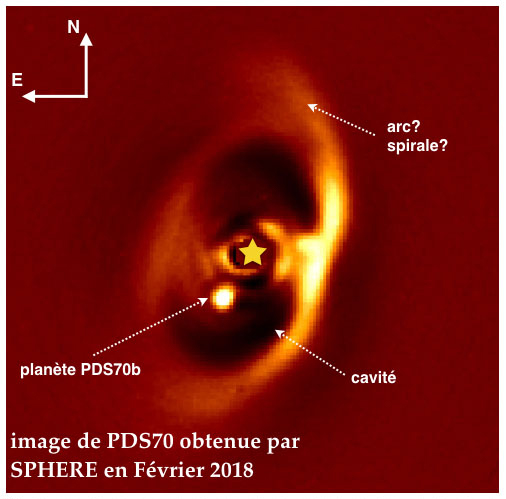The presence of cavities and rings in the protoplanetary discs surrounding young stars has for a long time been attributed to the presence of planets in the process of being formed.

En haut de l’image, apparaît un arc, peut-être un bras spiral, en bord de la cavité.
The planet PDS70b oribts its star at a distance of 22 astronomical unts, with a period of about 120 years.
This stellar system is at a distance of 113 parsecs, or 370 light years, so that the planet was hard to detect, since it is only 0.2’’ from its star.
The orbital motion of the planet could be seen by comparing observations made by SPHERE in 2015, 2016 et 2018 with those made by other instruments - NACO at the VLT and NICI at South Gemini.
Near infra-red spectroscopic observations (0,96 to 3,8 microns) indicate a temperature in the range 1 000 to about 1 600 Kelvin, ce qui devrait correspondre à une masse de l’orson avec les modèles d’atmosphères suggère également la présence de nuages dans son atmosphère.

Certain models suggest a relatively large size up to 3.7 jovian radii, which is unusual. It is possible that the planet is in the process of accreting gas even as it orbits within the disc.
Two papers published by M. Keppler and A. Müller (Max Planck Institute for Astronomy in Heidelberg) present the discoçvery and the characterization of the disc and the planet.
SPHERE has also obained polarimetric observations which, combined with observations of the luminosity, enable one to constrain the properties of the dust of which the disc is composed (and in particular the size of the grains). The disc has a cavity which extends over 54 astronomical units, within which is the planet.
Contributions from LESIA scientists
This imporrtant discovery made by SPHERE opens the road to new ways to study and better understand the formation and evolution of planets.
LESIA scientists have contributed to this discovery, both for the detection and the characterization of the disc and the planet.
SPHERE is an instrument installed at the Very Large Telescope since 2014 : it was developed by a consortium of European laboratories led by the lThInstitut de Planétologie et d’Astrophysique de Grenoble (IPAG).
The Laboratory for Space Studies and Instumentation in Astrophysics of the Paris Observatory has participated in many ways in the development of this instrument.
Publication
- Discovery of a planetary-mass companion within the gap of the transition disk around PDS 70, Keppler M. et al., publié dans Astronomy & Astrophysics. arXiv.org, vol. astro-ph.EP. 29-Jun-2018
- Orbital and atmospheric characterization of the planet within the gap of the PDS 70 transition disk, Müller A. et al., publié dans Astronomy & Astrophysics, arXiv.org, vol. astro-ph.EP. 29-Jun-2018
